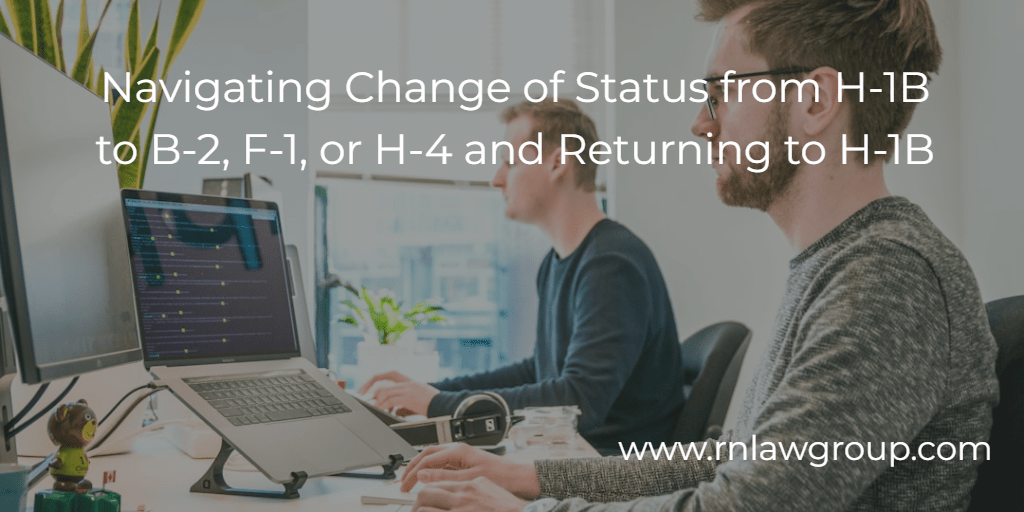
Navigating Change of Status from H-1B to B-2, F-1, or H-4 and Returning to H-1B
As the landscape of U.S. immigration policies continues to evolve, understanding the options available to nonimmigrant workers following the termination of employment is essential. One key area of concern for H-1B visa holders facing job loss is whether they can change their status to a B-2 visitor visa, F-1 student visa, or H-4 dependent visa while seeking new employment. This article addresses the current procedures and possibilities for such transitions, especially when a company subsequently files an H-1B petition with a request for premium processing service.
Background: Filing Change of Status to B-2, F-1, or H-4
When an H-1B visa holder faces termination, the individual is typically given a 60-day grace period to find new employment or change their nonimmigrant status. One common option is to file Form I-539 to change status to B-2 (visitor), F-1 (student), or H-4 (dependent) to maintain legal status while seeking a new employer.
USCIS has clarified that the process of changing to B-2, F-1, or H-4 can be initiated even while the individual is searching for a new employer. Once a change of status is filed, the nonimmigrant maintains lawful status while the application is pending. However, the question that arises for many is whether, while a change of status is pending, the individual can move back to H-1B if they find a new employer willing to sponsor them.
Filing an H-1B Petition While B-2, F-1, or H-4 Change of Status Is Pending
The answer, in short, is yes. Even when a change of status to B-2, F-1, or H-4 is pending, it is possible for a new employer to file an H-1B petition on the individual’s behalf. USCIS has specifically stated that when a Form I-129 petition for H-1B is filed with a request for premium processing, they will generally process the pending I-539 (B-2, F-1, or H-4) together with the I-129 petition. This means there is no delay in adjudicating the H-1B petition due to the pending change of status application.
Once the H-1B petition is approved, the individual will automatically obtain the new H-1B status, without the need to depart the United States. The pending I-539 for B-2, F-1, or H-4 will essentially become irrelevant, as the individual will have successfully changed back to H-1B status. This streamlined process offers a significant advantage to H-1B workers, as they are not required to exit the country to obtain a new visa at a consulate, thus minimizing the risk of long delays or potential re-entry issues.
March 2023 USCIS Policy Change
In March 2023, USCIS issued new guidance reaffirming that individuals with pending B-2, F-1, or H-4 applications can still pursue a change back to H-1B if they secure new employment. This policy change was in response to the increasing number of H-1B workers affected by job losses during the economic downturn. The guidance highlighted that USCIS will prioritize and process the H-1B petition together with the pending I-539, allowing for concurrent decisions.
It is important to note that this policy also applies to those with pending H-4 or F-1 change of status applications. In other words, if an individual had applied to change their status from H-1B to H-4 (for example, due to a spouse’s employment) or from H-1B to F-1 (to return to school), and later secures an H-1B job offer, the employer can file an I-129 petition on their behalf. USCIS will process both applications concurrently, thus allowing the individual to switch directly to H-1B without departing the U.S.
Practical Considerations for Employers and Employees
For employers, this policy provides a valuable option to rehire talented foreign workers who were forced to file for a B-2, F-1, or H-4 change of status following job termination. The ability to file a premium processing H-1B petition means that employers can quickly bring these workers back on board, avoiding the time and expense associated with sending the employee abroad for visa stamping.
For employees, it is essential to maintain legal status throughout the transition period. Even if a change of status application to B-2, F-1, or H-4 is pending, finding new employment and switching back to H-1B remains a viable option. The premium processing feature ensures a quick turnaround, providing workers with peace of mind and avoiding any gaps in employment.
Future Implications
The March 2023 policy update is a reflection of USCIS’s efforts to adapt to the challenges faced by nonimmigrant workers, especially in times of economic uncertainty. By allowing workers to transition seamlessly from H-1B to B-2, F-1, or H-4 and back to H-1B, USCIS has created a flexible system that benefits both employees and employers. This development is particularly significant for the tech and engineering sectors, where many foreign workers rely on the H-1B visa.
. Similarly, those applying for F-1 or H-4 must meet the specific criteria for those visas.
Conclusion
At Reddy & Neumann PC, we are committed to helping employers and employees navigate these complex immigration processes. The ability to file an H-1B petition while a B-2, F-1, or H-4 change of status is pending provides a significant advantage for both parties. With our extensive experience in business immigration, we ensure that our clients remain compliant with U.S. immigration laws while exploring all available options. Whether you are an employer seeking to rehire a valued worker or an employee in search of new opportunities, we can guide you through the process and help secure a successful outcome.
If you have questions about your immigration status or need assistance with filing petitions, please do not hesitate to contact us.
By: Rahul Reddy
Rahul Reddy, a seasoned lawyer in the realm of employment-based immigration, is the founding partner of Reddy Neumann Brown PC With an impressive career spanning over 28 years, he inaugurated the firm in 1997, bringing a wealth of knowledge and a unique perspective to the intricate landscape of immigration law.
Rahul’s understanding of the complexities inherent in the immigration system is vast and nuanced, making him an indispensable resource in this specialized field. This comprehensive expertise, coupled with his personal encounters with the immigration system, has imbued him with a profound empathy for his clients. Each case he undertakes is informed by this personal connection, as he understands the unique challenges and aspirations that drive individuals to navigate the immigration process.
Passionate and committed, Rahul is driven by a desire to assist others in realizing the quintessential American Dream. His mission, underpinned by years of professional experience and personal insight, remains focused on providing excellent legal support to those seeking employment-based immigration solutions.

